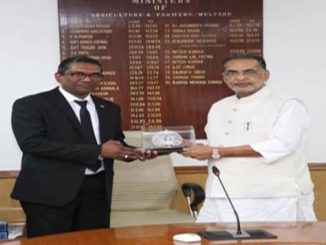The impacts of COVID-19 on the livestock sector are still largely incalculable and yet to be fully felt. Formal assessments have not yet been possible, but current observations reveal disruptions to livestock value chains. Learning from past epidemics indicates these disruptions are likely to fatten, along with their terrible, socio-economic consequences. Fortunately, actions can be taken to protect this sector and its activities, services and products upon which the whole world relies. The various effects of this Covid 19 pandemic are:
Decreased sale and consumption
The closure of fast food outlets, crisis in the hospitality industry led to fall in milk product and poultry meat consumption. Since restaurants are shutting up sales of products such as khoya and skimmed milk powder have completely dried up. According to CRISIL Report- “product can’t be made at home such as flavored milk, cheese and khoya – had not found their way back to table as before the lock down. The ice- cream manufacturer worst impacted by the pandemic, the demand dipped by 60- 70 percent. Dairy sector witnessed about 30-35 % reduction in the initial weeks of lockdown. Unemployment and Economic slowdown have left people (including migrants worker in India) with little or no income to buy food. This reduction in purchasing power of consumers also led to decrease in sale of livestock products
Fake news and rumours can also affect demand. In India, chicken sales were reduced significantly after posts on social media created the impression that humans could contract COVID-19 by consuming chicken. In Pune Farm– gate chicken prices dropped about 60% in south India in January after the rumor that chicken consumption spread Covid- 19.

Effects on Animal production
- Reduced availability to animal feeds: Social distancing and shortage of personal protective gears have been reduced the efficiency of industrial feed enterprises. Restricted movement and illness are resulting in labor shortages and reduced supply of raw materials or other ingredients. Disruption of supply and trade routes has further curbed feed supply.
- Reduced access to inputs and services: Transport restrictions and disruption of national and international routes is reducing farmer access to breeding materials and replacement stocks (e.g. day-old chicks and semen). This can compromise sales for input providers. The disruption of public services (e.g. food safety inspection and animal health extension services), combined with interrupted delivery and use of vaccines and medicines is increasing the likelihood of new epidemics, including those involving animal diseases that cause major livestock losses and outbreaks of diseases transmissible to humans. Import restrictions will have greater impact on areas which depend on imports to sustain production or rely on meat and dairy imports for consumption.
- Reduced access to markets: Closure of live animal markets in many parts of country means small-scale producers cannot sell their goods. The disruption of the logistical channel and drop in demand were reducing sales and lowering prices. As a result of limited access to markets and slaughterhouses/processing plants, farmers had to keep their stock longer or dump milk, left them with higher production costs or important losses.
Effects on Processing
- Diminished processing capability: Meat and milk processing industry has labour intensive nature and facing shortage of staff due to lockdown measures, quarantine and sick leaves taken by workers. This led to diminished capability of processing of animal and animal product.
- Compromised storage and up keeping: Some collectors were forced to stock up due to change in consumption habit, retailing and interrupted transport.
Effect on transport
- National transport: Interstate and intra state transport restriction reduced the supply of livestocks and livestock goods. Fisher folk were being forced to dump their catch back into the sea due to the closure of ice factories, fishing harbors, and transportation facilities to move their cargo.
- International transport: restriction on trade affected countrie. Spred of covid 19 pandemic has slashed export of Indian carabeef. Sale of Indian buffalo meat is 100,000 tonnes / year but in March 2020 export dropped to around 40,000 tonnes. Livestock traders, producers, butchers lost their income as they were unable to sell their products.
Mitigation Strategies
Farmers are in cavernous distress after this pandemic and lockdown caused commotion in the food supply chain, insufficiency of labour and resulted in a decline in demand. To boost the morale of farmers, the government must come out with a monetary package that takes care of their loan this year not only from banks and lending institutions but also from the informal sector. The world needs solution. That’s why the Director-General of the UN Food and Agriculture Organization (FAO) has urged G20 leaders to take measures to ensure that global and national markets continue to be a transparent, stable, and reliable source of food supply. It is essential that we keep global food chains alive amid COVID-19.
Actions can take form of policies and retort contextualized to fit into national frame works, while assuring compatibility with public health measures to suppress COVID-19 transmission. The following mentioned options are provided for consideration by to alleviate the impact of COVID-19 on the livestock sector.
Providing farmers timely information
Farmers need factual information, helping tips, and advisories to carry on their work. The ICAR- I.V.R.I. (Indian Veterinary Research Institute) has developed extensive advisories on various facets of safe and hygienic meat, milk, and egg production along with safe handling, transportation and marketing to deal with lockdown situations. ICAR has reconciled to the current lockdown situation by sharing these advisories via different online channels, social media, Facebook, YouTube and WhatsApp. The pandemic has forced us to look at these channels to remain linked with the farmers and other stakeholders.
Linking farmers to markets: This is often not terribly new, since it’s been stressed long before, however linking producers and marginal farm businesses to market and input agencies was never previously realized as much as what we are now realizing important and trying to act upon under the lockdown situations. This has caliber to attenuate the impact of supply chain disruptions
Developing programs of practices
Under splendid conditions like COVID-19, we require to have a package deal of practices including “Do’s & Don’ts” which farmers can observe to confront the crisis. For Example, the National Dairy Development Board (NDDB) in India has reconstitued components for lockdown-hit farm animals feed plants. This is possibly to assist in attaining the milk manufacturing objectives of dairies that had been suffering for farm animals feed throughout the national lockdown.
Encouraging farmer producer organizations (FPOs)
The FPOs, if delegated, could address market disruptions within the wake of pandemics like COVID-19. Some FPOs in Asian nation have shown their potential in handling the present crisis. The EAS suppliers in India, like Krishi Vigyan Kendra (KVKs) are mandated to make FPOs. They seem to escalate their efforts after Covid-19 lockdown experiences.
Extend guidelines for COVID-19 prevention, control and management with the supply chains to protect value chain actors and their families. These guidelines ought to embody provisions for heightened bio-security, personal protective equipment and hygiene. Offer grants to extend packaging and freeze capacities. Small- and medium-sized enterprises and factories ought to be inspired to provide safe merchandise with long shelf lives.
Organize mass slaughtering points and support the installation of the cold chain to scale back unregulated slaughtering and improve meat examination.
Find alternative ways to provide animal-protein-rich foods to school children to improve nutrition through feeding programs and smallholder incomes. Encourage group milk collection and transport of milk to processing companies.
Develop emergency management protocols, system and services as well as communication procedure to control rumors, aware stakeholders and to get feedback. Redistribute employees and resources to crisis relief activities, along with availability of movement permits, disease
control and food examination.
Financial measures
Provide money transfers facilities to milk collection booths and processing units to maximize milk supply purchasing power and processing long-shelf products (e.g. UHT, powdered milk).
Facilitating small and medium sized businesses mitigate short-term COVID-19 impacts via dedicated monetary facilities (e.g. temporary tax relief, emergency loan programs, direct stimulus payments, tax exemptions, overdue loan repayments extension, grace periods, low interest rates and direct public investments and subsidies.)






Be the first to comment